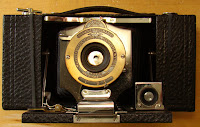


The small picture is an old one, but typically mid-sixties: 127 HP3
(eBay!) in the Starluxe and look how good the cheap box and the 45+ film perform. Chapeau!
But of course in this decennium colour-photography became normal. Remember those evenings you had to see àll the slides uncle Herbert made in Spain! So I thought it would be appropriate to put some Macocolor in the 1965 Starluxe II.
TETENAL COLORTEC
30 Years ago I had my share of darkroom-colour: additive/subtractive, positive/negative, Cibachrome, the lot. So why not try it again. 5 Cameras, 2 films (Agfa + Maco), different procedures, a proper test. And here are the results:
Tetenal recommends 38 degrees, 3,5 minutes, but 30 degrees would be possible. Which I did, the first time, fresh stuff, Paterson drums, only turning the spiral around. Well - don't do that: I got stripes, very badly. The 30 degr/8 minutes was o.k.
Two days later, also 30 degrees, but now I shook the drums every 30 secs: no stripes, but a dark red mask. Tetenal's advise: bleach again. Didn't work, alas.
(All 5 cameras were boxes, so both the UCN 200 and the Optima 400 wère overexposed.)
5 Days after that, 5 minutes at 35 degrees and Shakin'Jeroen: great result. Nice colour, bright mask.
Hot-dried the film will curl up, just give it time to cool down: no problem. (Remember: when wet, it's a bit "milky".)
Conclusion: Tetenal Colortec - easy to use, good result, for 2 tenners worth a try. Take the higher temperature and: "shaken, not stirred"
motion is essential! (Put some gloves on!)
Oct 2011: Colortec could be better when older: today's Maco in over 9 weeks old "coffee" was perfect!
(All results: Flickr photostream erwinruys)






 Yes - colour was not common - in Gibson's "Miracles of Photography" (±1912) there are only three chapters about colour-photography (50 years after James Clerk Maxwell's first colour-photograph!) and I couldn't get any Autochrome (so beautiful!) alas.
Yes - colour was not common - in Gibson's "Miracles of Photography" (±1912) there are only three chapters about colour-photography (50 years after James Clerk Maxwell's first colour-photograph!) and I couldn't get any Autochrome (so beautiful!) alas.  So we put some Agfa in the Kodak, developed it in Colortec and see how this meniscus performs today! Isn't it great?
So we put some Agfa in the Kodak, developed it in Colortec and see how this meniscus performs today! Isn't it great? 

































